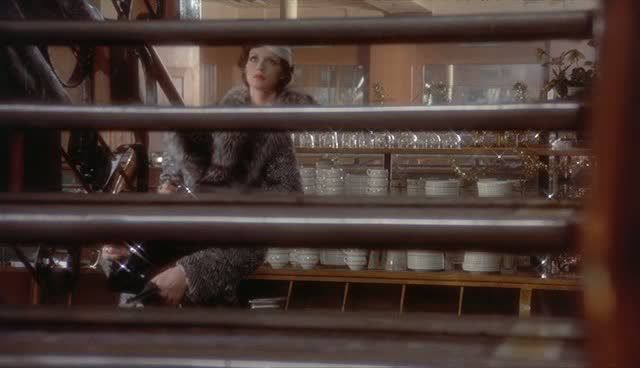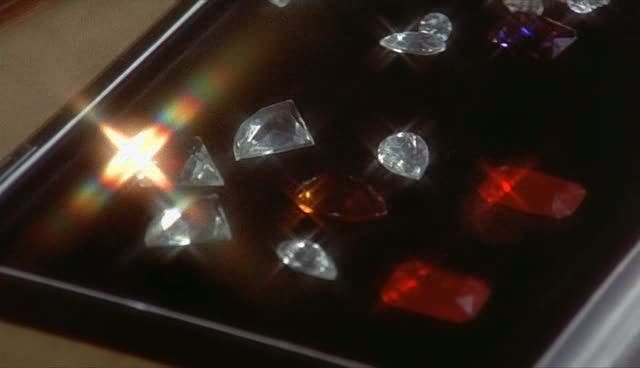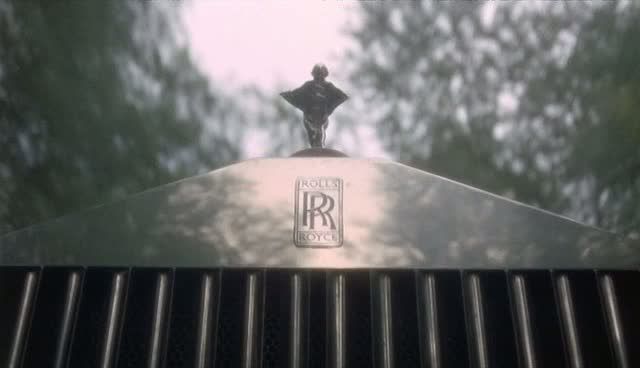

With Stavisky..., Alain Resnais has made a film that seems to be all about appearances and surfaces, but uses its glossy, charming — but ultimately tragic — gangster story as a way of exploring questions of identity and politics. The story of the conman Stavisky (Jean-Paul Belmondo), who reinvents himself as the sophisticated financier and businessman Serge Alexandre, takes place in the crucial years of 1933-1934, a period of slowly increasing tension in the lead-up to the Spanish Civil War and World War II. The film is based on real events that inspired right-wing riots on February 6, 1934, leading indirectly to the gradual loss of power by leftists and socialists within the French government. The film was written by Jorge Semprún, who had also written Resnais' La guerre est finie in 1966; like that film, Stavisky... engages with European fascism and leftism through questions of identity and personality. Stavisky/Alexandre is a man of many names, many identities, a small-time crook who has put his past behind him and become a well-respected member of society, dealing with high-ranking politicians and businessmen, coming up with grand plans that would impact the entire world economy. Stavisky is hiding from his past, at times acting as though the man he was is someone else entirely, with no connection to his present self at all.
Resnais connects this denial of self with the question of Jewish identity during a time of steadily increasing anti-Semitism in the years before the Holocaust would begin in earnest. Stavisky is a Jew, and a self-denying Jew, just like his father, who had entirely repudiated his faith. But he's self-denying in an entirely different way from his father, who had always advised him to be "average," to let people ignore him; Stavisky doesn't believe in this advice. As one of his employees says about him, "He wanted the world to talk about him. He should have wanted it to forget him." Stavisky's grand plans only draw attention to him, make him a target, impossible to ignore or to forget. In this, he is compared to a refugee German actress (Silvia Badescu) who he sees giving an audition in his theater: she stands up on stage and announces that she is a Jew, that she has fled from Germany. She is announcing her identity up front, hiding nothing, very unlike Stavisky, whose Jewish roots are deeply buried beneath layers of alternate identities and invented names. Perhaps that's why he's so moved by her, although their stories only intersect briefly. He sees in her a pride and a strength of character that, despite all his bravado and his smiling confidence, is utterly missing in him because he can never truly be himself. And yet Stavisky, in his own way, also refuses to be "average," refuses to hide or to congenially assimilate into society. Instead, he places himself out in the open, using the connections he builds to ingratiate himself into polite society, politics and the inner workings of the world economy.
It's this domain of privilege and power that serves as the film's milieu. The film is set almost entirely in fancy hotels, glitzy seaside casinos, resorts for the idle wealthy. The camerawork of Sacha Vierny accentuates the shiny, colorful veneer of these surroundings. The camera drifts lovingly over the facades of these pleasure palaces — although Stavisky, who says that happiness is momentary and pleasure permanent, would likely not call them that — and revels in the excess and grandiosity of this lifestyle. Jewels glitter brightly, sparkling with stars of white light. The women, like Stavisky's beloved wife Arlette (Anny Duperey), are dressed in fine furs and sleek dresses, their made-up faces surrounded with shimmering jewels. Everything is glamorous and draped in riches, even in the midst of the Great Depression, which hardly seems to have touched the social circles that Stavisky operates in. The lively Stephen Sondheim music makes the film seem like a musical with no real musical numbers, just the sprightly accompaniment of Sondheim's jaunty melodies and romantic string themes. Alexandre puts on theater productions, giving the public garish spectacles to distract from the real conditions of the world for ordinary people. As his employees tell him, no one wants frugality in their entertainment, they want to be entertained and delighted by everything they don't have in their own lives. The film is dripping in ostentatious displays of wealth and privilege, set in a fantasy world that seems entirely disconnected from both the poverty of most people and the brewing political turmoil that would throw the entire world into chaos and horror by the end of the decade.


That turmoil rarely intrudes in obvious ways into the world that Stavisky has built for himself, and yet he's surrounded by signs of what's to come. He has associates and friends on both sides of the political spectrum, especially among rightists like the charming, cheerful fascist Baron Jean Raoul (Charles Boyer), who wants to replace France's parliamentary government with a National Union comprised of wealthy, influential society people. Stavisky also nurtures his connections with Juan Montalvo (Roberto Bisacco), a Spanish exile who's gathering funds and weapons to trigger a civil war back in his native country. Stavisky involves himself in wild schemes, financed with fake bond issues, to rejuvenate the world economy and end unemployment, but the real future is to be found in the plans of his friends, who plot against the left with the help of this disguised Jew, who barely thinks about the political consequences of his associations. He says that he remains neutral, that he'll support whoever is in power and forge connections on both sides to cover himself in any eventuality, but he never seems to grasp the deeper implications of the platforms that these polite fascists are really pushing for.
The film's political subtext also involves the parallels and connections between Stavisky and the exiled Leon Trotsky (Yves Peneau), who arrives in France in the opening scenes of the film. Resnais then cuts from Trotsky's motorcade to an image of Stavisky/Alexandre descending in an elevator in one of his posh hotels. Just to underscore the point, Resnais cuts back and forth a few times, stuttering the image between Trotsky's car and Stavisky in his elevator; the hotel scene is accompanied by lushly romantic strings, while no music plays over the images of Trotsky. This montage at first seems like a simple joke, juxtaposing the arrival of this important political figure with the lavish lifestyle of the conniving gangster, but the parallels between the two men go deeper than that. Both are Russian Jews in exile, and by the end of the film, the failure of Stavisky's criminal schemes will have catapulted the rightists to power and endangered Trotsky's position in France. Throughout the film, Stavisky's showy existence and denial of his roots is contrasted against Trotsky's quiet maintenance of his beliefs and his low-key engagement with the radical politics of the era.
Although the film's surface period evocation is flawless — the art direction is sumptuous and detailed — Stavisky... is far from a typical period epic. Resnais, as he often does, uses non-chronological editing to fragment the narrative, weaving together flashbacks and flash-forwards that foreshadow and then outright depict Stavisky's downfall and death while he's still at the height of his power. In one key sequence, Stavisky goes walking in the woods, visiting the house where his father, embarrassed of his son's criminal record, committed suicide. As Stavisky prepares to leave the site, Resnais cuts in for a surreal closeup of a dead mouse that Stavisky steps past without seeing it, a symbol of the doom that he can't see coming. (Later, a white ermine frolicking in the snow serves as a prelude to Stavisky's actual death; Resnais loves playfully using animals as mysterious symbols like this.) The film's interpretation of the real-life Stavisky Affair suggests that the title character was unwittingly responsible for many of the failures of French leftism in the pre-WW2 era, haplessly paving the way for the Vichy regime and the victories of French fascism.
"Although the film's surface period evocation is flawless — the art direction is sumptuous and detailed — Stavisky... is far from a typical period epic. Resnais, as he often does, uses non-chronological editing to fragment the narrative, weaving together flashbacks and flash-forwards that foreshadow and then outright depict Stavisky's downfall and death while he's still at the height of his power. In one key sequence, Stavisky goes walking in the woods, visiting the house where his father, embarrassed of his son's criminal record, committed suicide. As Stavisky prepares to leave the site, Resnais cuts in for a surreal closeup of a dead mouse that Stavisky steps past without seeing it, a symbol of the doom..."
ReplyDeleteThis is a fascinating piece, even though I have not watched this film to this point. Resnais is a New Wave giant of course, and anything that bears his name is essential for the most ardent cineastes. Certainly 'identity' and 'politics' are among Resnais' most examined themes, and the fact that it was written by Jorge Semprun, who also authored the great LA GUERRE EST FINIE tells us all we need to know.
A motivating piece in every sense.
Stavisky... is the most scrumptious of resnias' masterpeices. A Big Commerical Star vehicle AND a rich and complex "art film" at the same time, it's every bit the work of the the man who made Muriel.
ReplyDeleteResnais was living in New York in the early 70's (I know because I used to run into him all the time) and he went to see Company and Follies over and over again. The last number of "Follies "Live Laugh and Love" he said perfectly encapsulated the heart of Stavisky. . . as it involves a character in the middle of big proiduction number who has "gone up on his lines" and can't get back. He screams for help as the entire set collapses around him. (I saw the origanl production twice.)
Some of the underscoring for Stavisky partiularly the music the hotel band plays in the lobby scene, is derived from numbers Sondheim wrote for Follies that were cut out of town.
The other major influence is sacha Guitry whose verbal wit is evoked in the great scene where Stavisky runs after the would-be actress Erna Wolfgang at rehearsals and bets her he can make her smile by the time he walsk her to the door. The charm of the dialogue is brought to glowing life by jean-Paul Belmondo in the greatest performance of his career.
Here's Ron Raines doing the number in the recent revival
ReplyDeleteThanks, Sam. This is a fine movie, another great one from Resnais - but no surprise there, I've yet to find a misstep as I go through his work.
ReplyDeleteDavid, nice background on the genesis of this film. The Sondheim music is integral to the film's mood, blending perfectly with the lavish production design and period detail, contributing to the sense of this as a BIG picture. And yes, this is one of Belmondo's finest moments, a very sensitive and subtle performance that just hints at everything going on within this extraordinarily complex figure.
The Resnais, BTW, is the SECOND movie about Stavisky. The first Stolen Holiday was made in 1937 -- not long after the events depicted in it. Claude Rains played the Stavisky figure and Kay Francis his wife. Michael Curtiz directed and it's really quite good. It shows up on TCM every blue moon. Look for it.
ReplyDeleteHuh, that sounds really interesting, David. Will definitely have to keep an eye out for that one.
ReplyDelete